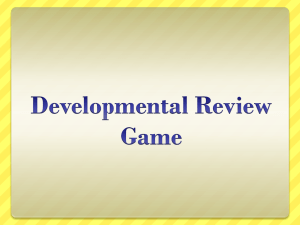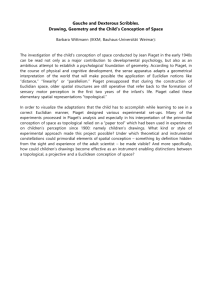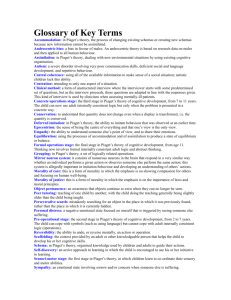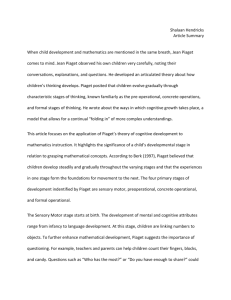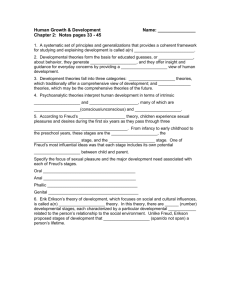Homage to Jean Piaget
advertisement
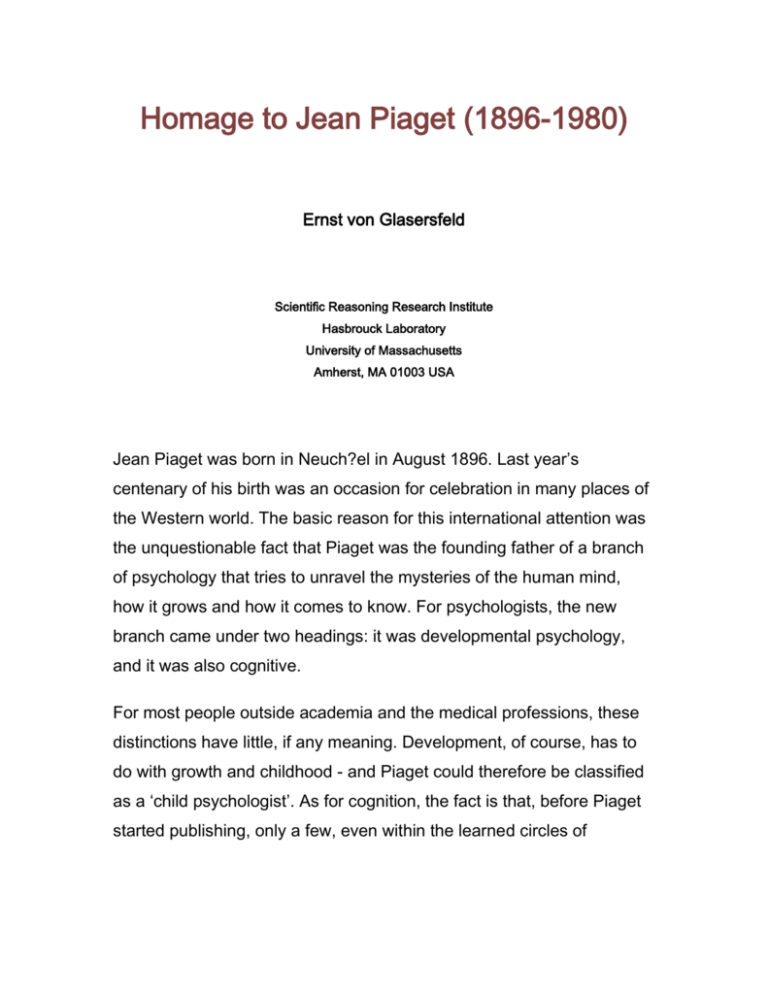
Homage to Jean Piaget (1896-1980) Ernst von Glasersfeld Scientific Reasoning Research Institute Hasbrouck Laboratory University of Massachusetts Amherst, MA 01003 USA Jean Piaget was born in Neuch?el in August 1896. Last year’s centenary of his birth was an occasion for celebration in many places of the Western world. The basic reason for this international attention was the unquestionable fact that Piaget was the founding father of a branch of psychology that tries to unravel the mysteries of the human mind, how it grows and how it comes to know. For psychologists, the new branch came under two headings: it was developmental psychology, and it was also cognitive. For most people outside academia and the medical professions, these distinctions have little, if any meaning. Development, of course, has to do with growth and childhood - and Piaget could therefore be classified as a ‘child psychologist’. As for cognition, the fact is that, before Piaget started publishing, only a few, even within the learned circles of academia, had a clear picture of how the study of cognitive development should differ from the earlier pursuits of psychologists. Development has to do with growth and childhood, and consequently, when Piaget was first discovered in the United States - about 1940 - he was classified as a child psychologist. Twenty years later, he was discovered once more as the author of a theory that postulated four stages in the development of intelligence. Finally, in the 1980s, he was rediscovered for the third time, as the progenitor of constructivism. Since then, constructivism has become fashionable, especially in the educational domain. Many writers call themselves constructivists, but few have fully understood the revolutionary aspect of Piaget’s theory. In what follows I shall present my interpretation. A Theoretical Model of Cognitive Development The term ‘psychology’ obviously comes from the Greek word psyche for which my old Greek dictionary gives the English words "the soul or spirit of man" and then "mind, reason, understanding". Many thinkers in the course of history have pondered these entities. The study of the soul goes back at least to St.Augustine, the study of spirit to the alchemists, and that of mind, reason, and understanding has been the unwavering focus of philosophy since Descartes. It was the last three that interested Piaget, because they are central in our conception of knowledge, and he approached them in an altogether novel way. The notion of cognitive development was far from central in psychology. The first decades of our century saw the rise of experimental psychology, which brought with it an exclusive - and I would say maniacal - interest in the observable. What could not be actually seen and measured in experiments, preferably in the rarefied atmosphere of a laboratory, could no longer be counted as science and was therefore disregarded. In the United States, this development had its climax with Professor Skinner and his ‘radical behaviorism’ in the 1930s. Psychology was now defined as ‘the science of behavior’, and for radical behaviorists, the mind, the entire world of concepts, meanings, purposes, intentions, and indeed knowledge was discarded as a bunch of pre-scientific, mentalistic superstitions. Piaget’s approach also went counter to well established ideas in philosophy. Most philosophers considered knowledge as a static entity. Knowledge, for them, was there, ready to be discovered. The notion that individuals could generate knowledge, and that one could specify the processes involved in its production, was not a notion that fitted the traditional pattern. How something arises and comes to be what it is, its evolution, was not to be considered a justification or valid explanation. Indeed, philosophers had formulated a ban against ‘genetic fallacies’. However, Piaget was from the beginning interested in development, and after a few studies of biological organisms, he turned his interest to the development of knowledge. Already as a teenager he had been puzzled by the process of biological adaptation. He studied it with mollusks by transplanting them from lakes to running water and vice versa, and he observed the different shape of the shells the mollusks developed as an adaptation to the dynamics of their environment. In retrospect, when he had worked as a scientist for well over sixty years, he wrote in his Foreword to the most important English collection of his writings: My central aim has always been the search for the mechanisms of biological adaptation and the analysis and epistemological interpretation of that higher form of adaptation which manifests itself as scientific thought. (Piaget, 1977a, p.XI) This constitutes a revolutionary shift of attitude. Science is no longer seen as the path towards a ‘true’ understanding of the real world, but as a tool of adaptation. Although Piaget followed a purely biological way of thinking, it led him to a theory of knowing that is perfectly compatible with that of modern physicists. Both biologists and physicists acknowledge that the conceptual structures that we consider to be ‘knowledge’ are the products of active knowers who shape their thinking to fit the constraints they experience. Einstein explained this in 1938 with the help of a striking metaphor: Physical concepts are free creations of the human mind, and are not, however it may seem, uniquely determined by the external world. In our endeavor to understand reality we are somewhat like a man trying to understand the mechanism of a closed watch. He sees the face and the moving hands, even hears its ticking, but he has no way of opening the case. If he is ingenious he may form some picture of a mechanism which could be responsible for all the things he observes, but he may never be quite sure his picture is the only one which could explain his observations. He will never be able to compare his picture with the real mechanism and he cannot even imagine the possibility or the meaning of such a comparison. (Einstein & Infeld, 1967, p.31) An Experiential World instead of Reality When scientists observe, they categorize their observations by fitting them into concepts which they have formed on the basis of prior experience. These concepts are not given. They are the result of imaginative abstractions from a particular way of seeing or sensing. These ways of seeing or sensing are those of particular scientists. And when scientists explain, they do it by relating things to one another - and the relations they use, again, are not given, but are the result of their own abstracting from the mental operations they carried out in order to combine what they have seen or sensed. When Einstein says in the last part of his metaphorical story that the scientist cannot even imagine how the mechanism he or she has invented could possibly be compared to an independent reality, he is far ahead of the today’s average scientist. The great physicists, however, have in one way or another acknowledged that their models are abstractions from human experience. Just how individual these abstractions are, comes out in the comments the great physicists sometimes made about each other’s revolutionary ideas. When Einstein read Schršdinger’s first paper on wave mechanics, he wrote to Max Born that he did not believe it, and Heisenberg considered it "disgusting" (Holton, 1988, p.169). Thus, both Piaget and the leading physicists were acknowledging the fact that observers did their observing and explaining in terms of concepts that were their invention. Piaget was the first methodically to employ this notion in psychology and to proceed on the assumption that our ideas are individual creations (and that their mutual compatibility with those of others has to be achieved by social interaction). The essential functions of the mind consist in understanding and in inventing, in other words, in building up structures by structuring reality. (Piaget, 1971, p.27) Expressed in the English title given to one of his books: ‘To understand is to invent’ (1973), it created an uproar and was fiercely criticized. Most of the critics had no idea that Einstein had said exactly the same. It is of considerable historical interest to note that while the physicists became aware of the decisive role the observer played in scientific observation and theory construction, Piaget published La naissance de l’intelligence chez l’enfant (1936) and La construction du r?l chez l’enfant (1937). The two books, which have remained fundamental in his theory of cognition, provided a model of how an active thinker - whether scientist or layman - may come to have a relatively coherent picture of the world. The core of his theory of knowledge was summarized by Piaget in his conversations with Jean-Claude Bringuier: I think that all structures are constructed and that the fundamental feature is the course of this construction: Nothing is given at the start, except some limiting points on which all the rest is based. The structures are neither given in advance in the human mind nor in the external world, as we perceive or organize it. (Piaget, 1977b, p.63). The Concept of Adaptation Piaget came to this conclusion, not as a physicist, not as a psychologist, but as a biologist. From the theory of evolution, he imported the concept of adaptation into the study of cognition. To grasp the full extent of this epistemological shift, one needs to be clear about what precisely ‘adaptation’ means and how it works. There is a wide-spread notion that adaptation is an activity carried out by living organisms when they are being pressed by the environment. The case of the mollusks may serve as an example. It is as though a growing mollusk could notice that the water around it flows quickly, and that the shell it is building had therefore better be flat, so that it offers less resistance. From an evolutionary point of view, such a notion is even worse than the Lamarckian heresy. What Piaget intended, was that the building of a mollusk’s shell is genetically determined as a function, but what this function produces, may depend on the specific constraints of the environment. The important thing is that the mollusk builds a shell that allows it to survive in spite of the constraints that hem it in. To put it generally, an organism must fit, i.e. be viable within the constraints of the environment. In this context, to fit means to be adapted - and adaptedness, as Piaget has said explicitly, is tantamount to the ability to survive.(Piaget,1976,p.18) This perspective brings with it an important insight: If the constraints of the environment can be avoided at all, there is not only one way of doing it, but an unspecifiable number of ways. This is the reason why adaptedness does not reflect the structure of the environment - it merely shows one way of not coming into fatal conflict with it. It is this principle that characterizes Piaget’s approach to the problems of cognition. Although he followed a purely biological way of thinking, it led him to a theory of knowing that is perfectly compatible with that of modern physicists. Both acknowledge that the conceptual structures that we consider to be ‘knowledge’ are the products of active knowers who shape their thinking to fit the constraints they experience. (Note that experiments in physics cannot provide a privileged access to reality, they are merely cleverly contrived and controlled experiences.) In Piaget’s theory of cognition there are two levels of adaptation. On the practical level of survival, it is a matter of devising schemes of action that circumvent the obstacles and perturbations the environment places in the organism’s path. On the conceptual level of theories and explanations it is a matter of achieving a coherent balance that avoids internal contradictions. A Break with Philosophical Tradition There is a great deal of resistance against this view of knowledge, and of scientific knowledge in particular. The philosophical tradition has for more than two thousand five hundred years perpetuated the notion of human knowledge as the more or less ‘true’ representation of a real world. This view has dominated absolutely and it is no wonder that people find it difficult to change their perspective. No matter how often Piaget has reiterated that our knowledge is not and cannot be a picture of the world as it might be in itself, his theory is nevertheless taken as a description of reality. This is a colossal distortion and leads to contradictions that cannot be resolved. In Piaget’s model, knowledge has to be seen as a collection of schemes of action and models of thinking that allow us to live and move in the world as we experience it, The two views of science and the cognitive processes that produce it are incompatible. On the one side, there are the realists, for whom the essence of science lies in the collecting of ‘objective’ data which, they believe, speak for themselves and automatically provide true explanations. Knowledge, for them, is the result of discovery. On the other side is Piaget’s constructivism, for which all science is the product of a thinking mind’s conceptualization. From this perspective, knowledge does not ‘represent’ or depict an independent reality but is a collection of inventions that happen to fit the world as it is experienced. This dichotomy, of course, did not begin in our time. In fact, it goes back all the way to the Pre-Socratics five or six centuries before the birth of Christ. "Thought and being are one and the same," said Parmenides and then he proceeded to think up a metaphysics that might explain how the world could exist in itself, without a thinker. And the whole of Western philosophy followed his lead. From Plato to Whitehead and most contemporary philosophers, the fundamental problem was twofold: on the one hand, the task was to provide rational knowledge of the real world; on the other, it was to provide an explanation of how we could attain such knowledge. Although the sceptics had demonstrated quite irrefutably that the senses are fallible, the philosophical tradition did not relinquish the faith, and implicitly continued to trust observation. Seeing was still believing, because what you see must have been there before you saw it - that is, it must exist. In one way or another, philosophers escaped into metaphysics. The prime example is Descartes, who, at the end of all his doubting, simply asserted that God could not have been so mischievous as to equip us with deceptive senses. At some point even physicists tend to turn to metaphysics. Einstein did it by stating a simple act of faith: "God does not play dice." This was a playful way of stating his faith that God was rational and his reason had to be accessible to us. We could therefore assume that He had arranged His creation so that the human mind could invent laws that actually turn out to be laws of nature. Some other thinkers made their move into metaphysics more elaborate. I find this endearing, especially when it is honestly presented as a conjecture. The Irish philosopher George Berkeley, for instance, stated quite clearly that the only form of ‘being’ his rational thought could grasp was a being which his senses could substantiate with repeatable evidence. In order to ‘exist’ in itself, that is without a human observer, the world required faith in a God who could keep it constant by His divine perception. But Berkeley’s logic was generally misunderstood and so was his metaphysics. He did not claim that our picture of the world is ultimately like God’s reality, he merely posited God’s world as an independent substrate that allowed the human mind to construct its own. The deliberate separation between rational thinking and metaphysics as the domain of mystical intuitions was not understood by Berkeley’s contemporaries nor by most of his later readers. Consequently, in much of the literature, he is condescendingly referred to as ‘Bishop Berkeley’ as though he might be important to religion, but irrelevant to philosophy. Separation from Metaphysics It is a strange coincidence that in 1710, the year of Berkeley’s first major work, Giambattista Vico published a thesis on epistemology in which he comes to similar conclusions. Rational knowledge, he said, does not concern what exists in a real world, but is the knowledge of how we make the world we experience. Only God can know what reality is like, because He Himself has created it. Although Vico has been rediscovered as the pioneer of sociology and philosophy of history, his theory of knowledge has been persistently disregarded. Yet, as the first explicit expression of a constructivist orientation, it is immediately relevant to a discussion of Piaget’s genetic epistemology. As far as I know, Piaget was unaware of Vico. Yet, there is a remarkable fit between his ideas and those of the Neapolitan philosopher. The basic commonality lies in the notion that what we call knowledge is the result of our own construction. The difference lies in the way the two thinkers see the relation between knowledge and the real world. For Vico an intuitive correspondence is warranted by the fact that both the real world and the human mind are God’s creation. For Piaget, there is no iconic correspondence, but knowledge fits functionally into the real world because it is an evolutionary adaptation. Piaget has repeated this point innumerable times, but it is still the most profoundly misunderstood feature of his theory. His readers and interpreters seem to remain forever unaware of the simple fact that ‘adaptation’ does not involve the replication of the structures to which an organism has adapted. Adaptation is, in fact, a negative concept. It does not require any knowledge of what really exists - it merely implies that whatever is functionally successful will live and reproduce itself. It is the result of trial and the elimination of what does not work. The fact that an organism is ‘adapted’ only shows that it has found a way of coping with the world in which it lives - it does not show what a world might be like before it has been perceived and conceived by a particular living organism. The focus, now, is on knowledge as an instrument of adaptation that enables the organism to steer clear of external perturbations and internal contradictions. Knowledge thus turns into a tool in the pursuit of equilibrium, and its purpose is no longer the representation of a ‘real’ world. This constitutes the major difference between Piaget’s ‘Genetic Epistemology’ and the ‘Evolutionary Epistemology’ that has recently become a fashion. Both schools take a stand against Kant’s notion that our concepts of space and time are ineluctably innate in the human mind. For Piaget, they are constructs whose build-up begins very early, namely in the course of what he called ‘circular reactions’ during the first two years of the infant’s cognitive development. The concepts of space and time arise in conjunction with those of object permanence and causality, and Piaget has provided at least an approximate model of how these concepts could be built up (Piaget, 1937). For evolutionary epistemologists, such as Konrad Lorenz and Gerhard Vollmer, "Adaptation to a given circumstance of the environment means acquiring information about that given circumstance" (Lorenz, 1979, p.167). Therefore the fact that our spatio-temporal picture of the world has proven an eminently successful adaptation, is considered proof that space and time are properties of ‘reality’. From what I have said about Piaget’s view of adaptation, however, it should be clear that the success we have had with the concepts of space and time does not warrant a conclusion about the real world - it merely shows that these concepts are extremely useful in the organization of our experience. Earlier I suggested that it is difficult to step out of our millenary philosophical tradition. Both Vico and Piaget were aware of this difficulty. In one of his replies to a critic, Vico went to great lengths to establish a relatively simple point: given that his treatise claimed that the knowledge of things and causes that we construct is not knowledge of God’s truth and can only be proven in its application, it is absurd to request a proof that it is ‘true’ in the conventional sense. Piaget’s theory of knowledge, and today’s constructivists who have built on it, find themselves in the very same position. It does not help reiterating that their aim is not to furnish a true picture of the world, but rather a way of organizing experience. They are judged and then commended or criticized as though they proposed a metaphysics. In short, the fact that they are trying to change the concept of knowledge is disregarded and they are assimilated to the conventional epistemological view. It is characteristic that Vico, although he did not use this term, formulated a first example of assimilation. It is another property of the human mind that whenever men can form no idea of distant and unknown things, they judge them by what is familiar and at hand. (Vico, 1744/1961, p.18) In Piaget’s theory of cognition, this is the first of three basic principles. The mind primarily assimilates, that is it perceives and categorizes experience in terms that are already known. Only if the result of this process causes a hitch and creates a perturbation, a review is initiated that may lead to an accommodation. This is to say, it may give rise to change in an existing structure or the formation of a new one. This second principle provides a mechanism for learning and should therefore be of interest to teachers of all kinds. The Power of Reflection What, then - to repeat a frequent question - generates a readiness to learn? Surely it is primarily the realization that what we already know is not sufficient to deal with a problem that we actually want to solve. It would seem a simple enough maxim - but in my experience it is rarely followed. Yet, it would change the atmosphere in most classrooms. Piaget’s third principle is that of reflective abstraction. This, too, is not a thoroughly new invention. Who has read John Locke, may remember that in his Essay concerning human understanding, he said about reflection: the ideas it affords being such only as the mind gets by reflecting on its own operations within itself. (Locke, 1690, Book II, 4) Piaget elaborated the notion of reflection on mental operations, and provided a model for how it operates in conjunction with abstraction and generalization. Thus he provided a theory of learning that successfully resolves the so-called ‘learning paradox’, a problem we inherited from Plato. It concerns the generation of new knowledge, which in Plato’s theory was God-given and accessible only through the mystical pipeline of reincarnation. Piaget’s reflective abstraction opened the door to fortuitous conjecture, the kind of imaginative ‘what-if’ assumptions that Charles Peirce incorporated in logic as abduction. I see abduction as an integral part of accommodation. Peirce described it as a simple process. If we experience a surprising event - it may be a pleasant surprise or a disagreeable one - we try to discover what caused it. If we isolate some novelty in the situation, we may conjecture a rule that says: if such and such is the case, we get this surprising result. This conjecture constitutes an abduction, because it is not drawn from prior experience. We may then test the hypothetical rule - and if it is confirmed, we have an accommodation, because we have in fact generated a new rule that can serve us as a scheme of action. There is nothing paradoxical in this form of learning, nor does it require a mystical explanation. What it does require is an active mind that is able to reflect upon what it perceives and upon its own operations. There is no doubt that we have such minds. Let me give you a very simple example. It is a charming anecdote I read, but cannot remember where. A little girl is walking, and every now and then she pushes her ball to roll ahead. As the path begins to go up a hill, the ball, to her surprise, comes rolling back. And she asks: "How does the ball know where I am?." The little girl’s question demonstrates that she is at least to some extent aware of her experience and can reflect upon it. Only a reflective mind, a mind that is looking for order in the baffling world of experience, could formulate such a question. It is the kind of question that, after innumerable further trials and untenable assumptions, would lead an imaginative thinker with the stamina of Galilei, to an explanatory principle such as ‘gravitation’. We have no idea what it is that gives us this internal awareness and the power to reflect. But we know that we have it. As you are listening to me now, you can become aware of your own listening. And as I am speaking to you, I can become aware of what I am doing and ask myself, why can I not say all this more simply? - We know that we can reflect, but we do not know how. We may call it awareness or consciousness, and then put a ‘self’ in front of it, but this does not explain - we have no model of a mechanism that could produce such an effect. Piaget himself, throughout his work, remained extremely reticent about the nature of consciousness. In his Insights and Illusions of Philosophy (1971), he discussed his disagreements with the definitions of consciousness of Bergson, Husserl, Sartre, and other philosophers, but refrained from presenting an explanatory model of his own. In La prise de conscience (1974) - a title that, as Leslie Smith has pointed out, should be translated as "The attainment of consciousness", he provided evidence that consciousness is not an all-or-nothing phenomenon, but has several successive levels. Finally, and I think most significantly, he explained in his conversations with Jean-Claude Bringuier: ‘We study behavior, including consciousness when one can attain it, but when one cannot attain it, it is no problem. (Piaget, 1977, p.18) From modern logic we know that theories, as a rule, contain assumptions which they themselves cannot justify. From my point of view, consciousness, or operational awareness, is an element that any model of cognition cannot do without, even if its mechanics have to remain unexplained. Much of the criticism that has been leveled against Piaget’s notion of reflective abstraction, therefore, seems rather hollow to me - at least until someone comes up with an explanation of consciousness that shows Piaget’s use of the concept to be mistaken. Ever since Piaget published his first important works in the 1930s, people have tended to react in different ways. On the one hand, conventional psychologists tried to assimilate his theory to traditional ideas, and in order to do this, they had to disregard whatever did not fit and the heftiest chunk that could not be fitted into a conventional view was, of course, the constructivist principle that we ourselves build our picture of the world in which we live. Most textbooks of psychology nowadays contain a few pages about Piaget, but I have not yet seen one in which the constructive principle of genetic epistemology is properly stated. Piaget’s theory does not only concern knowledge, but it also concerns the generation of knowledge. Social Interaction On the other hand, many of those who acknowledged the principle of individual construction of knowledge, accused him of disregarding the role of social interaction. In the English-speaking world, this may be partly due to the fact that Piaget’s 1965 volume ƒtudes sociologiques is practically unknown. A translation has only recently become available, and the delay of more than thirty years has obviously done a certain amount of damage, because in the meantime Vygotsky’s work has been advertised as the only source of relevant answers. In his "Sociological Studies", Piaget analyzes the processes of social interaction in far greater detail than any of the authors, who focus on the social rather than the individual construction of knowledge. As far as I can see, in all their vigorous recommendations of the social perspective they do not explain the mechanisms of social influence any further than did Vygotsky when he wrote: Human learning presupposes a special social nature by which children grow into the intellectual life of those around them. (Vygotsky, 1978, p.88) From my constructivist point of view, this is very similar to Chomsky’s declaration that the basic structure of language is innate - a declaration that simply precludes investigation into how language might be generated by those who are born into a linguistic community. Piaget, in contrast, presented a list of the types of knowledge whose acquisition seems to require social interaction as opposed to those that do not. In his view, the organization of immediate experience, the sensorimotor intelligence that manifests itself in simple action schemes, and the basic ability to consider one thing as the symbolic substitute for another, are cognitive functions of the child before it has any conception of other people, let alone their common social practices. Conscious reflection, on the other hand, arises for Piaget - very much as it does for Humberto Maturana, another pioneer of the biology of cognition - in the context of interaction or collaboration with others. This does not happen at once, but as Piaget said: [The child] is socialized in the same way as it adapts itself to the external physical environment. (Piaget, 1965, 264) It happens as a result of the ‘decentering’, i.e. the becoming aware of other points of view, which is a prerequisite for the successful interaction with other deliberate agents. It is crucial to realize that in all this, Piaget is speaking of functions, not of the conceptual results they may produce. Hence it is clear that Piaget did not ignore the role of social interaction. In fact he specified several patterns of its operation - for instance collaboration and coercion - and he was fully aware of the role of authority and power. But he also saw clearly that there was a great deal of knowledge which the human individual could acquire by him- or herself. Let me give you two examples in widely different fields. Some of you may have witnessed this striking phenomenon: Some infants invent a quite spectacular method of scooting across the room while sitting on their pots. They have certainly not been prompted, nor have they ever seen it performed by an adult. It is wholly their own accomplishment, constructed, one might say, in splendid isolation. A similar, but culturally more significant feat, I believe, was accomplished a long time ago by Pythagoras. He may have been sitting on a terrace in Samos or Metapont, idly staring at the pattern of the tiled floor. It was the popular pattern of congruent isosceles triangles set in squares that Socrates later used in Plato’s Meno. Suddenly Pythagoras saw that the squares formed over the long side of a triangle contained four of the triangles, and the square formed over the short side contained two. It was the first conception of the theorem that was to make him famous for thousands of years. In both cases a startling piece of new knowledge is constructed by an independent individual mind. Having had some interactions with ‘social constructionists’ in this country, I expect that a zealous disciple of that school would immediately counter by saying that these anecdotes prove their point, because both the pot and the tiled floor are social artifacts. I think this misses the mark, because the pot was not designed for locomotion and the tiles not for geometry. A New Way of Seeing In such spontaneous construction, as in all intellectual advances, the new idea springs from a new way of seeing. It is a novelty that was not contained in the physical material or the social context. It had to be generated by an individual’s novel organization of perceptual and conceptual material. To me this constitutes a fundamental difference of perspective and intent. The socially oriented investigators of cognition look at the human organism from the outside and attempt to explain its actions, and the knowledge it acquires, in terms of what they consider a pre-existing environment including society and linguistic communication. This view is still caught up in the belief in a passive observer that governed science before the 20th century. The constructivists who follow Piaget, attempt to think in a way that includes the observer. They are trying to devise a model that may show one way in which intelligent organisms, who start their thinking career in the middle of their own experience, could possibly come to have concepts of others, of themselves, and of an environment, and could ultimately arrive at a comprehensive non-contradictory complex of livable ideas. This enterprise, although it is far from complete, has a wonderfully invigorating effect. No longer do we have to think of ourselves as powerless, passive receivers, who are not only physically but also mentally determined by the structures of a pre-established universe. Instead, we become aware that our thoughts and actions are ours, and that it is we who have generated them and therefore have to assume responsibility for what we think and do. I would claim that this leads to a significant change of intellectual attitude - and so I close my homage to Jean Piaget by thanking him for having carved out a path along which we might eventually come to have a truly human conception of the world. Bibliography Einstein, A., & Infeld, L. (1967) The Evolution of Physics. New York: Simon & Schuster. (German: 1938.) Locke, J. (1690). An essay concerning human understanding. Lorenz, K. (1979). Kommunikation bei Tieren. In A.Peisl & A Mohler (Eds.), Der Mensch und seine Sprache (167-180), Frankfurt-Berlin-Wien: Ullstein. Piaget, J. (1936). La naissance de l’intelligence chez l’enfant. Geneva: Delachaux et Niestl? Piaget, J. (1937). La construction du r?l chez l’enfant. Geneva: Delachaux et Niestl? Piaget, J. (1965). Etudes sociologiques. Geneva: Librairie Droz. (Note: my page indication refers to the Italian translation by Barbetta, 1989. Piaget, J. (1971) Science of education and the psychology of the child. New York: Viking Press (French: Psychologie et p?agogie, 1969). Piaget, J. (1973). To understand is to invent. New York: Grossman (French: O?va l’?ucation?, 1948). Piaget, J. (1974). La prise de conscience. Paris: Presses Universitaires de France. Piaget, J. (1975) Insights and illusions of philosophy. New York: Meridian Books (French: 1965) Piaget, J. (1976). Le comportement, moteur de l’?olution. Paris: Gallimard. Piaget, J. (1977a) Foreword to H.E.Gruber & J.Von?che (Eds),The essential Piaget. London: Routledge and Kegan Paul. Piaget, J. (1977b). Foreword. In J-C. Bringuier, Conversations libres avec Jean Piaget, Paris: Editions Laffont. Vico G-B. (1744) The new science, translation by T.G. Bergin & M.H.Fisch, New York: Anchor Books, 1961. Vygotsky, L.S.(1978). Mind in society: The development of higher psychological processes. Cambridge, Massachusetts: Harvard University Press. ******* Home Oikos Ecology of Mind Co-ordination page Antipsychiatry Links Kelly Maturana Von Glasersfeld Laing Bateson
